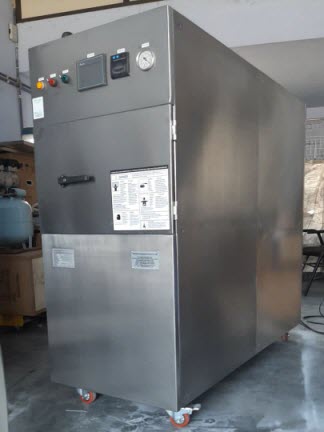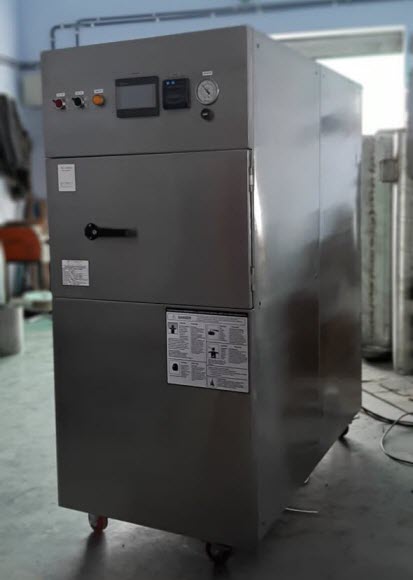German hospitals prioritize patient safety and infection control by relying on cutting-edge ETO sterilizers. These advanced devices play a crucial role in maintaining aseptic conditions within medical facilities. By effectively eliminating pathogens, including bacteria, viruses, and spores, ETO sterilizers prevent healthcare-associated infections (HAIs) and safeguard both patients and medical staff.
The Ethylene Oxide (ETO) sterilization process involves using a gas that penetrates medical equipment and devices, reaching even the most intricate parts. This deep-level sterilization ensures that all surfaces are thoroughly disinfected, leaving no room for potential contamination.
With the growing concern over antibiotic-resistant organisms, ETO sterilizers offer a reliable solution for tackling such challenges. By eradicating these superbugs, German hospitals can reduce the risk of cross-contamination and HAIs, thereby enhancing patient care and recovery outcomes.
In addition to their efficacy, ETO sterilizers also contribute to sustainability efforts. Their lower energy consumption and minimal water usage align with eco-friendly initiatives in the healthcare sector. Moreover, the reusability of some ETO sterilized medical equipment further reduces waste generation.
By embracing the use of ETO sterilizers, German hospitals demonstrate their commitment to maintaining high standards of infection control and promoting the well-being of patients and healthcare professionals alike.
Advancing Surgical Instrument Sterilization
In German hospitals, the pursuit of optimal patient safety during critical surgical procedures is bolstered by cutting-edge techniques of Ethylene Oxide (ETO) sterilization. These advanced methods ensure the effective disinfection of complex surgical instruments, mitigating the risk of infections and complications.
Complex surgical instruments, such as endoscopes and robotic surgical tools, often contain intricate components that are difficult to clean thoroughly using conventional methods. ETO sterilization addresses this challenge by using a gaseous sterilant that can penetrate narrow crevices, lumens, and hard-to-reach areas of the instruments. This comprehensive disinfection process eliminates even the most resilient pathogens, making it a preferred choice for critical procedures.
The meticulous nature of ETO sterilization guarantees that surgical instruments are not only free from visible debris but also devoid of microscopic contaminants. This level of sterilization is vital to prevent post-operative infections, which can significantly impact patient recovery and outcomes.
Furthermore, German hospitals prioritize safety by adhering to strict validation and compliance standards for ETO sterilization. Regular validation ensures that the sterilization process consistently meets quality and safety benchmarks, offering an added layer of reassurance for patients and medical professionals alike.
Incorporating ETO sterilization in surgical instrument preparation optimizes operating room efficiency. Surgeons can rely on impeccably sterilized instruments, minimizing the risk of delays due to re-cleaning or equipment replacements. This efficiency translates to improved patient care and reduced hospital costs.
As technology continues to advance, German hospitals stay at the forefront of sterilization innovation. Ongoing research and development efforts aim to enhance the efficacy and speed of ETO sterilization, ensuring it remains a cornerstone of patient safety in critical surgical settings.

ETO Sterilization: Vital for Medical Device Manufacturing
Ethylene Oxide (ETO) sterilization plays a pivotal role in the production process of medical devices in German healthcare. This indispensable method ensures that medical devices are delivered in a pristine and uncontaminated state, adhering to strict regulations and upholding the highest standards of quality and safety.
The complexity of modern medical devices often involves intricate components, including electronics, plastics, and delicate materials, which may not withstand high-temperature sterilization methods. ETO sterilization offers a gentler alternative, as it operates at lower temperatures, preventing damage to sensitive devices while still achieving thorough sterilization.
German healthcare regulations mandate stringent validation and compliance protocols for medical device manufacturing. ETO sterilization must undergo rigorous testing to ensure its effectiveness in eliminating microorganisms and achieving a sterility assurance level (SAL) that meets regulatory requirements. This commitment to validation guarantees that the sterilization process consistently delivers reliable results, safeguarding patients and healthcare practitioners.
Moreover, ETO sterilization is highly effective against a broad spectrum of microorganisms, including bacteria, viruses, and spores. Its gas-based nature allows it to penetrate packaging materials and device crevices, ensuring all surfaces are thoroughly disinfected. This comprehensive sterilization is crucial for preventing potential infections and complications when medical devices come into contact with patients.

Environmental Impact & Safety Measures
In the realm of medical device sterilization, Ethylene Oxide (ETO) sterilizers stand out for their eco-friendly aspects and low environmental footprint. German healthcare facilities have implemented stringent safety protocols to not only protect personnel but also to ensure a sustainable and responsible approach to sterilization.
ETO sterilizers offer several eco-friendly advantages that align with environmental preservation efforts. One key aspect is their low energy consumption during the sterilization process. Compared to some high-temperature sterilization methods, ETO sterilization requires less energy, contributing to reduced greenhouse gas emissions and conserving valuable resources.
Furthermore, ETO sterilization operates at lower temperatures, minimizing the overall environmental impact. This attribute is particularly beneficial for medical devices with sensitive components that may be susceptible to damage from higher temperatures.
German healthcare facilities prioritize safety in every aspect of their operations, including the use of ETO sterilizers. Rigorous safety protocols are implemented to protect both personnel and the environment.
Employees working with ETO sterilizers undergo specialized training to handle the equipment and sterilants safely. They are equipped with personal protective equipment (PPE) to minimize any potential exposure to the sterilant.
ETO sterilization chambers are equipped with state-of-the-art monitoring systems that constantly assess gas concentrations, ensuring they remain within safe levels. These systems have built-in alarms that activate if the levels approach critical thresholds, alerting personnel to take immediate action.





